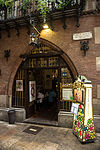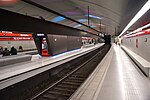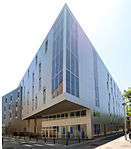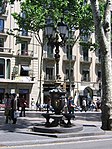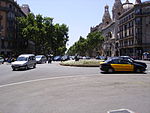Portal de l'Àngel

Portal de l'Àngel (Catalan pronunciation: [puɾˈtal də ˈlaɲʒəl]) is a pedestrian street in the Ciutat Vella district of Barcelona adjacent to Plaça Catalunya and part of the large shopping area that spans from Avinguda Diagonal to Barri Gòtic. It's one of the city's most visited streets and is always crowded with tourists and locals all year round. Portal de l'Àngel is noteworthy for being the most expensive street in Spain, with an average rental price of €265 per square meter in 2013.There is a large El Corte Inglés department store in this street, just opposite a building that has a giant thermometer in its façade. It's also home to other international shopping brands, including Zara, Massimo Dutti, and Benetton.
Excerpt from the Wikipedia article Portal de l'Àngel (License: CC BY-SA 3.0, Authors, Images).Portal de l'Àngel
Avinguda del Portal de l'Àngel, Barcelona
Geographical coordinates (GPS) Address Nearby Places Show on map
Geographical coordinates (GPS)
| Latitude | Longitude |
|---|---|
| N 41.386666666667 ° | E 2.1719444444444 ° |
Address
Springfield
Avinguda del Portal de l'Àngel
08001 Barcelona (Ciutat Vella)
Catalonia, Spain
Open on Google Maps

